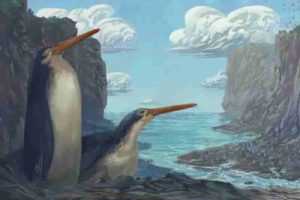
A giant fossilized penguin discovered by New Zealand school children has been revealed as a new species in the peer-reviewed Journal of Vertebrate Paleontology by Massey University researchers.
Penguins have a fossil record reaching almost as far back as the age of the dinosaurs, and the most ancient of these penguins have been discovered in Aotearoa. Fossil penguins from Zealandia (ancient Aotearoa) are mostly known from Otago and Canterbury although important discoveries have recently been made in Taranaki and Waikato.
In 2006 a group of school children on a Hamilton Junior Naturalist Club (JUNATS) fossil hunting field trip in Kawhia Harbour, led by the club’s fossil expert Chris Templer, discovered the bones of a giant fossil penguin.
Researchers from Massey University and Bruce Museum (Connecticut, United States) visited Waikato Museum Te Whare Taonga o Waikato to analyse the fossil bones of the ancient penguin. The team used 3D scanning as part of their investigation and compared the fossil to digital versions of bones from around the world. 3D scanning also meant the team could produce a 3D-printed replica of the fossil for the Hamilton Junior naturalists. The actual penguin fossil was donated by the club to the Waikato Museum in 2017.
Dr Daniel Thomas, a Senior Lecturer in Zoology from Massey’s School of Natural and Computational Sciences, says the fossil is between 27.3 and 34.6 million years old and is from a time when much of the Waikato was under water.
“The penguin is similar to the Kairuku giant penguins first described from Otago but has much longer legs, which the researchers used to name the penguin waewaeroa — Te reo M?ori for ‘long legs’. These longer legs would have made the penguin much taller than other Kairuku while it was walking on land, perhaps around 1.4 metres tall, and may have influenced how fast it could swim or how deep it could dive,” Dr Thomas says.
“It’s been a real privilege to contribute to the story of this incredible penguin. We know how important this fossil is to so many people,” he adds.
“Kairuku waewaeroa is emblematic for so many reasons. The fossil penguin reminds us that we share Zealandia with incredible animal lineages that reach deep into time, and this sharing gives us an important guardianship role. The way the fossil penguin was discovered, by children out discovering nature, reminds us of the importance of encouraging future generations to become kaitiaki [guardians].”
Mike Safey, President of the Hamilton Junior Naturalist Club says it is something the children involved will remember for the rest of their lives.
“It was a rare privilege for the kids in our club to have the opportunity to discover and rescue this enormous fossil penguin. We always encourage young people to explore and enjoy the great outdoors. There’s plenty of cool stuff out there just waiting to be discovered.”
Steffan Safey was there for both the discovery and rescue missions. “It’s sort of surreal to know that a discovery we made as kids so many years ago is contributing to academia today. And it’s a new species, even! The existence of giant penguins in New Zealand is scarcely known, so it’s really great to know that the community is continuing to study and learn more about them. Clearly the day spent cutting it out of the sandstone was well spent!”
Dr Esther Dale, a plant ecologist who now lives in Switzerland, was also there.
“It’s thrilling enough to be involved with the discovery of such a large and relatively complete fossil, let alone a new species! I’m excited to see what we can learn from it about the evolution of penguins and life in New Zealand.”
Alwyn Dale helped with the recovery of the fossil. “It was definitely one of those slightly surreal things to look back on — absolute bucket list moment for me. After joining JUNATS there were some pretty iconic stories of amazing finds and special experiences — and excavating a giant penguin fossil has got to be up there! A real testament to all the parents and volunteers who gave their time and resources to make unique and formative memories for the club members.”
Taly Matthews, a long-time member of the Hamilton Junior Naturalist Club, and who works for the Department of Conservation in Taranaki, says, “Finding any fossil is pretty exciting when you think about how much time has passed while this animal remained hidden away, encased in rock. Finding a giant penguin fossil though is on another level. As more giant penguin fossils are discovered we get to fill in more gaps in the story. It’s very exciting.”
The research was led by PhD student Simone Giovanardi, with Dr Daniel Ksepka, Bruce Museum and Dr Daniel Thomas, Massey University.
Reference:
Simone Giovanardi, Daniel T. Ksepka, Daniel B. Thomas. A giant Oligocene fossil penguin from the North Island of New Zealand. Journal of Vertebrate Paleontology, 2021; DOI: 10.1080/02724634.2021.1953047
Note: The above post is reprinted from materials provided by Taylor & Francis Group.










